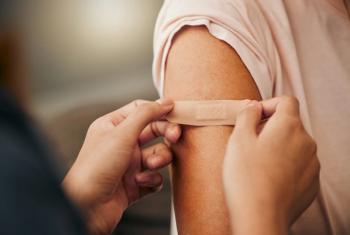Key takeaways:
- As tick activity extends later into the year, pediatricians play a key role in educating families on prevention, detection, and post-bite care.
- Tracey Gaslin, PhD, CPNP, FNP-BC, CEO of the Alliance for Camp Health, emphasized year-round prevention, correct tick removal, and region-specific awareness during well visits.
- With changing weather patterns and extended tick seasons, continued vigilance and family education remain essential for keeping children safe during outdoor play.
As tick activity extends later into the year, pediatricians continue to play a role in helping families recognize, prevent, and respond to tick bites. While most parents associate ticks with summer months, changing weather patterns have expanded the window of exposure well into fall, keeping prevention and education top of mind for clinicians.
In this Q&A, we interviewed Tracey Gaslin, PhD, CPNP, FNP-BC, CRNI, RN-BC, a dual-certified pediatric and adult nurse practitioner and CEO of Alliance for Camp Health, which created the Fight the Bite US Tick-Borne & Lyme Disease Initiative. Both the Alliance for Camp Health and the Fight the Bite initiative will be further explained below.1
In the following written discussion, Gaslin explains what general providers should discuss with families during well visits and outdoor activity seasons—from how to reduce risk and perform effective tick checks, to what symptoms warrant prompt medical attention. The conversation also explores regional differences in tick species, evidence-based repellents, and post-bite care recommendations, including when to consider antibiotic prophylaxis.
Together, these insights aim to support pediatric providers in guiding families through practical, preventive measures that can help children enjoy the outdoors safely while minimizing the risk of tick-borne disease.
Contemporary Pediatrics:
For the general provider, who will see children and teens at well visits and checkups, what should they be relaying to their patients when it comes to ticks? What care should they seek if they are bitten, and are certain bites more common than others?
Tracey Gaslin, PhD, CPNP, FNP-BC, CRNI, RN-BC:
For general providers seeing children and teens, it’s important to provide education on tick prevention and care. Prevention is always the first step of education that providers should be relaying to their patients to reduce their risk of tick exposure and tick-borne disease. When spending time outdoors, patients should be advised to wear protective clothing, use EPA-registered repellents, conduct tick checks after spending time outdoors, and if any ticks are spotted, promptly remove them.
Many individuals are unaware of being bitten by a tick until they are presented with symptoms, which is why early identification and treatment are important. Ticks can spread illnesses like Lyme disease, Rocky Mountain spotted fever, and ehrlichiosis – and if left untreated, symptoms and complications can become more severe.
Risk of tick exposure and disease depends on geography and seasonality, so knowing what tick species are common in your area and which ticks commonly carry diseases is crucial for parents and children. For example, blacklegged (deer) ticks, a common carrier of Lyme disease, are widely present across the Eastern United States and the greatest risk of being bitten exists in the spring, summer, and fall.2 Other species, such as the American dog tick, are typically found in areas east of the Rocky Mountains, with the highest risk of being bitten occurring during spring and summer.1
If parents notice their child developing a rash or if they experience symptoms like fever, fatigue, body aches, or chills, it’s important to seek immediate care from your healthcare provider. Lyme disease is diagnosed based on symptoms, physical findings, and tick exposure.1,3
Contemporary Pediatrics:
As we are in the fall season now, are ticks still a problem or concern for children who are playing outside (when leaves are falling), and out doing fall activities?
Gaslin:
Ticks can still be a concern for children playing outside in the fall. While spring and early summer are considered the peak of tick season, in some parts of the country, activity can extend from mid-August through November. Children playing outside are advised to avoid wooded and brushy areas with high leaf litter.4 Additionally, changing weather patterns and rising temperatures have extended tick activity later into the year, making continued prevention essential.5
Contemporary Pediatrics:
What are good techniques to check for ticks that perhaps families should know about, and can you talk about if there are any FDA-recommended repellents?
Gaslin:
Full body tick checks should be conducted after outdoor play, especially after time spent in wooded or brushy areas. Ticks are small and can be easily overlooked. Use a mirror to inspect all areas of the body, paying close attention behind the ears, along the hairline, under the arms, around the waist, and behind the knees, as well as checking clothing, shoes, and gear where ticks might latch on.
The FDA points to EPA-registered repellents as the standard for tick prevention. Repellents containing DEET (10–30%), like OFF! Deep Woods, or a picaridin-based repellent, like OFF! for Adults & Kids – suitable for parents and children ages 1 year and up, is commonly used.6 Other repellents include IR3535 and oil of lemon eucalyptus, although it’s not recommended for children under 3.1 To stay protected, families should always follow label directions, apply sunscreen before repellent, supervise children’s use, and wash repellents off once indoors.
Pediatricians can further protect children from ticks by combining preventive strategies with education and proper post-exposure care. The Alliance for Camp Health and SC Johnson’s Pediatrician Tick Education Tool provides guidance for pediatricians to use in their clinical practice, with helpful information on tick species by region in the United States, instructions on safe tick removal, and steps to take after a bite, including when to consult a healthcare provider and options for prophylactic treatment to prevent Lyme disease. Pediatricians can use this tool to educate families on proactive measures, ensuring children enjoy outdoor play safely while minimizing the likelihood of tick-borne illness.1
Contemporary Pediatrics:
Do you have any clinical pearls for providers when dealing with bites, and what should they and the family keep in mind, or do immediately, after a bite?
Gaslin:
Families should be reminded that after a tick bite occurs, quick and careful removal is key. Use fine-tipped tweezers to grasp the tick close to the skin and pull upward with steady pressure, then clean the area with soap and water or alcohol. Do not use folklore remedies like nail polish, petroleum jelly, or a hot match to make the tick detach.4,7
Documenting the date and time of tick removal can help with later identification should tick symptoms appear.8 If a patient experiences a tick bite, providers should assess the following:
- Where the bite occurred (in a state or county where Lyme disease is common)
- If the tick was removed within the last 72 hours
- If the tick’s body was flat or engorged with blood (Lyme disease risk is higher when the tick removed is engorged with blood)
- If the bite was from a blacklegged tick, the only tick in the United States that transmits the bacteria that causes Lyme disease
- Is doxycycline safe for the patient? A single dose of doxycycline has been shown to reduce the frequency of Lyme disease after a high-risk tick bite and is safe for people of all ages, including young children.9,10
In the days and weeks following a tick bite, signs of illness should be monitored, including rash, fever, fatigue, or joint pain. Seek medical attention promptly if symptoms develop.1,7
Contemporary Pediatrics:
How long do tick bites need to be monitored after they occur, and what sort of complications can occur? How can the pediatrician's office be prepared, and is this something they see a lot of in the office, or is it more of an at-home treatment for parents?
Gaslin:
Tick bites should be monitored for several weeks after they occur, as many tick-borne infections like Lyme disease can manifest within 3 to 30 days, or sometimes longer. Longer tick attachment increases the risk of transmission of tick-borne illnesses like Lyme disease, and in general, infected ticks must be attached for more than 24 hours to transmit infection.1,11,12
In some cases, complications can include erythema migrans (a characteristic “bull’s-eye” rash), fever, malaise, headache, myalgia, and joint aches.1 However, we do know that the rash does not appear in about 30% of cases.
In a pediatric practice, the office should be ready with protocols for tick removal, documentation (date, bite site, photograph of rash if present), criteria for prophylactic antibiotic use (in Lyme-endemic areas), and clear guidance for caregivers on symptom surveillance. Many tick bite cases are initially managed at home, but pediatricians often see follow-ups when suspicious rashes or other symptoms emerge. Having educational materials for families, a plan for follow-up, and familiarity with local tick-borne disease prevalence helps the practice be prepared.
Contemporary Pediatrics:
Is there anything else you would like to include?
Gaslin:
In addition to the new pediatrician tick education tool that’s part of our Fight The Bite initiative’s continuum of care, the Alliance for Camp Health continues to make major strides in tick and Lyme disease education at camps and summer programs across the country. The Fight the Bite initiative was created in 2024 in partnership with SC Johnson, a United States tick-borne and Lyme disease awareness initiative that extends the reach of Lyme disease and tick prevention through research, education, and creating Tick Aware spaces. The initiative provides camps, summer programs, and caregivers with free training, resources, and medical partnerships to create safer outdoor environments.13
In 2025, we expanded the program to 66 camps across the Midwest, including Michigan, Minnesota, Iowa, Indiana, Illinois, Ohio, Kentucky, Wisconsin, South Dakota, and Missouri, and have trained more than 6,000 staff members, protecting over 40,000 children from tick exposure and distributing nearly 2,500 units of OFF! for Adults & Kids Aerosol. I’m excited to keep growing the program next summer and share the importance of tick prevention with families and camp staff nationwide.
References:
- Fight the bite. Alliance for Camp Health. Accessed October 28, 2025. https://allianceforcamphealth.org/wp-content/uploads/2025/09/Digital-FTB.pdf?
- Where ticks live. Centers for Disease Control and Prevention. Updated July 30, 2025. Accessed October 28, 2025. https://www.cdc.gov/ticks/about/where-ticks-live.html
- About Lyme disease. Centers for Disease Control and Prevention. Updated August 26, 2024. Accessed October 28, 2025. https://www.cdc.gov/lyme/about/index.html
- Ticks. Alliance for Camp Health. Updated June 6, 2021. Accessed October 28, 2025. https://allianceforcamphealth.org/2021/06/06/ticks/
- Astor M. The tick season is getting worse. Here’s how to protect yourself. The New York Times. Published June 16, 2025. Accessed October 28, 2025. https://www.nytimes.com/2025/06/16/well/ticks-climate-change.html
- Regulation of skin-applied repellents. Environmental Protection Agency. Updated June 25, 2025. Accessed October 28, 2025. https://www.epa.gov/insect-repellents/regulation-skin-applied-repellents
- What to do after a tick bite. Centers for Disease Control and Prevention. Updated July 15, 2025. Accessed October 28, 2025. https://www.cdc.gov/ticks/after-a-tick-bite/index.html
- Lyme disease. Alliance for Camp Health. Updated January 27, 2022. Accessed October 28, 2025. https://allianceforcamphealth.org/2022/01/27/lyme-disease/?
- Nadelman RB, et al. Prophylaxis with single-dose doxycycline for the prevention of Lyme disease after an Ixodes scapularis tick bite. N Engl J Med. doi:10.1056/NEJM200107123450201
- Harms MG, et al. A single dose of doxycycline after an ixodes ricinus tick bite to prevent Lyme borreliosis: An open-label randomized controlled trial. J Infect. doi:10.1016/j.jinf.2020.06.032.
- How Lyme disease spreads. Centers for Disease Control and Prevention. Updated September 24, 2025. Accessed October 28, 2025. https://www.cdc.gov/lyme/causes/index.html?
- Lyme disease: What you need to know. Centers for Disease Control and Prevention. Accessed October 28, 2025. https://www.cdc.gov/lyme/media/pdfs/Lyme-Disease-What-you-need-to-know.pdf?
- “Fight the Bite” U.S. Tick-Borne + Lyme Disease Initiative. Alliance for Camp Health. Published January 2, 2024. Accessed October 28, 2025. https://allianceforcamphealth.org/2024/01/02/fight-the-bite-u-s-tick-borne-lyme-disease-initiative/










